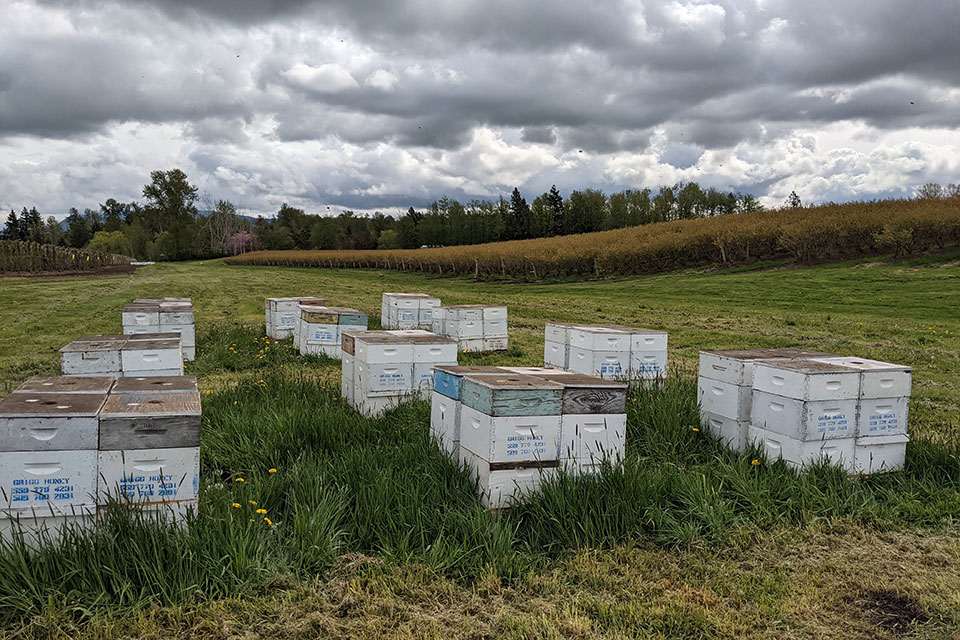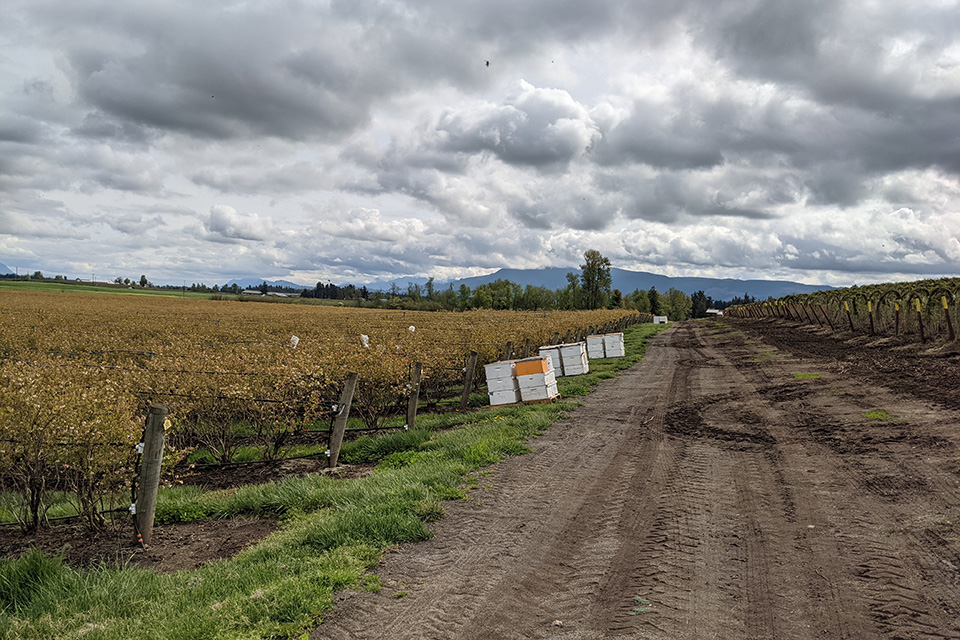Ways Blueberry Growers Can Best Maximize Pollination in Their Fields
Where blueberry growers ask their beekeepers to place honey bee hives may seem like a trivial matter. However, many growers and beekeepers would beg to differ. Historically, many growers have asked beekeepers to distribute hives throughout the fields, placing pallets in many small drops distributed near bushes to maximize pollination and yield potential. However, this increases beekeepers’ time to deploy and manage hives, requires more fuel, and puts the beekeepers at risk of getting stuck in fields that are often muddy.
Beekeepers are also limited on time during pollination, as hives must be moved at night, sometimes leaving beekeepers with only a few days to deploy hives. If beekeepers are asked to spend extra time and money placing hives, then it at least should result in increased yields for growers. Yet research guiding these practices has been scarce until now.
PLACEMENT AND POLLINATION
Many beekeepers have been advocating for larger drops of hives to save labor, fuel, and time. But does this more efficient placement strategy reduce crop pollination? To address this question, collaborating scientists in Michigan, Oregon, and Washington explored whether hive placement affects crop pollination. A total of 32 and 34 fields were monitored in 2021 and 2022, respectively, across all three states. Approximately half of the fields were assigned a “dispersed” treatment, where pallets of hives were spread out adjacent to the field edge. The remaining fields were assigned a “clumped” treatment, where pallets were clustered away from the field edge.

Example of clumped honey bee hive placement treatment.
Photo by Lisa DeVetter
Results showed fields with the clumped treatment had significantly higher honey bee visitation to blueberry flowers compared to the dispersed treatment under optimal weather conditions (e.g., air temperatures >55°F, sunny to partly sunny). However, when the weather was suboptimal, honey bee visitation was unaffected. Yield components and indicators of pollination success were interestingly not impacted by the placement treatments. This is likely due to the flowers being sufficiently pollinated despite differences in honey bee visitation.
Another dimension of hive placement is related to bee health. Beekeepers have observed declines in hive health following blueberry pollination. The reason(s) for these declines are not fully understood, but pesticide exposure has been identified as one potential contributing factor.
Growers frequently apply fungicides during bloom to protect their crop from fungal infections. Other pesticides may be applied too, such as insecticides for management of pests like aphids. While growers are taking action to minimize risks to their bushes during bloom, beekeepers are also concerned about minimizing risk to their hives by limiting pesticide exposure.

Example of dispersed honey bee hive placement treatment.
Photo by Lisa DeVetter
Pesticides were sampled during bloom at the same sites with hives in “dispersed” or “clumped” configurations by using silicone bands placed on hive exteriors. These bands measured drift onto the colonies from nearby spraying activities. The data from 2021 were highly variable, attributed to differences in spray programs; sprayer technology; what’s occurring in adjacent, non-blueberry fields; and weather. However, there was a trend of lower pesticide residues in the clumped hives for most sites.
The distance a hive is placed from the field edge likely impacts pesticide drift onto that hive, and this was explored further in 2023 using silicone bands. Results showed pesticide residues adjacent to the field edge are the same as those detected inside the field on the bushes, with residue levels declining significantly for hives placed more than 80 feet from the field edge. Further work is needed to characterize optimal distances for drift reduction.
PUTTING IT TOGETHER
What does this all mean and how can it be used to help growers and beekeepers? Our first takeaway is that clumping hives increases honey bee visitation to flowers and does not reduce crop pollination. In fact, there is potential for improved pollination for cultivars that are more challenging to pollinate. Clumping also can improve beekeeper efficiency during hive deployment, removal, and maintenance.
Interpreting the pesticide data is ongoing, but it seems that drift onto hives is reduced by placing them further from the field edge. This is context specific and depends on several factors. Research is ongoing to better understand these factors and create strategies for blueberry growers and beekeepers to work together to maximize blueberry pollination and their respective revenue stream.
Visit BlueberryPollination.org to learn more about the Blueberry Pollination project.
Special thanks to coauthors Meghan Milbrath and Rufus Isaacs at Michigan State University and Suzette Galinato at Washington State University
Acknowledgements: This work is supported by Specialty Crops Research Initiative Award 2020-51181-32155 from the USDA National Institute of Food and Agriculture. Any opinions, findings, conclusions, or recommendations expressed in this article are those of the author(s) and do not necessarily reflect the view of the U.S. Department of Agriculture.










